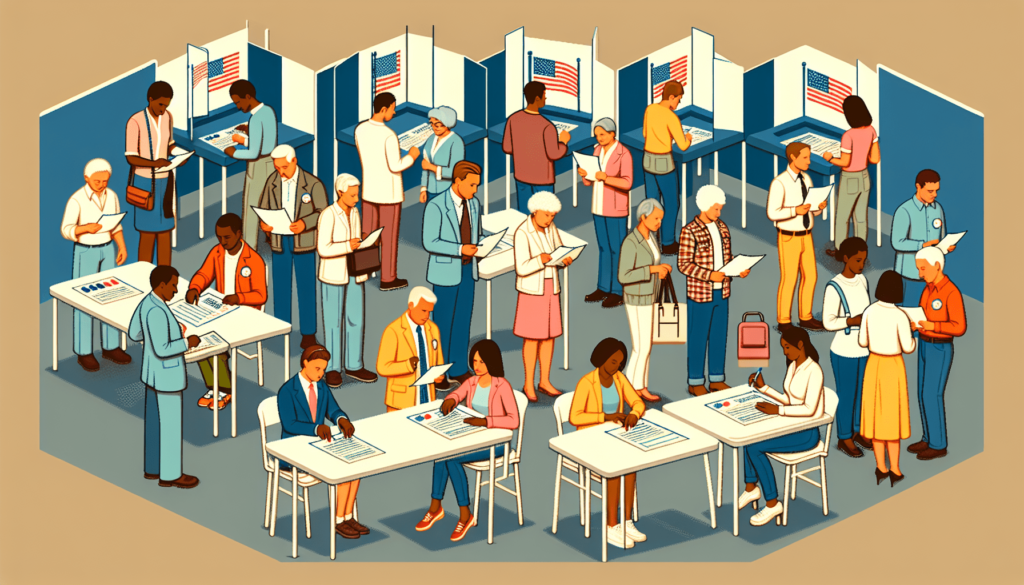Are you wondering how to effectively connect and engage with absentee and early voters? With increasing numbers of individuals opting for these voting methods, it is important to understand how to reach out to them in a meaningful way. By exploring different channels such as social media platforms, email campaigns, and personalized outreach, you can ensure that absentee and early voters feel valued, heard, and motivated to participate in the democratic process. Let’s explore some strategies and tips to engage with these vital members of our voting community.
Understanding Absentee and Early Voting
Definition of Absentee Voting
Absentee voting refers to the process of voting in an election by mail or other means when the voter is unable to physically attend a polling station on the designated voting day. This option is typically available for individuals who are unable to reach the polling place due to reasons such as being out of town, illness, disability, or military service. Absentee voting ensures that every eligible citizen has the opportunity to cast their vote and have their voice heard, regardless of their circumstances.
Definition of Early Voting
Early voting allows registered voters to cast their ballots in person before the scheduled Election Day. This option provides flexibility and convenience to individuals who may have conflicting schedules or face potential barriers on the designated voting day. Early voting periods can vary depending on the jurisdiction, but generally, it extends the opportunity for eligible voters to participate in the democratic process at a time that suits them best.
Importance of Engaging with Absentee and Early Voters
Engaging with absentee and early voters is crucial in promoting inclusivity and ensuring that all eligible citizens have the opportunity to exercise their right to vote. By reaching out to these individuals and providing information and support, we can help them overcome any obstacles they may face and encourage their active participation in the democratic process. Absentee and early voters play a significant role in shaping the outcome of elections, and engaging with them helps foster a sense of civic responsibility and inclusivity within our society.
Creating Awareness about Absentee and Early Voting
Education and Information Campaigns
To create awareness about absentee and early voting, robust education and information campaigns should be implemented. These campaigns can include public service announcements, advertisements, and informational materials distributed through various channels such as television, radio, and social media platforms. The goal should be to provide clear and concise information about the eligibility criteria, deadlines, and procedures for absentee and early voting, ensuring that potential voters are well-informed and able to make informed decisions.
Utilizing Social Media Platforms
Social media platforms have become powerful tools for reaching out to a wide audience. By utilizing platforms such as Facebook, Twitter, and Instagram, election officials can engage with the public and disseminate important information about absentee and early voting. Social media campaigns can include interactive content, Q&A sessions, and regular updates to keep potential voters well-informed and engaged. Platforms can also be used to address any concerns or queries raised by individuals regarding the voting process.
Collaborating with Community Groups and Organizations
Collaborating with community groups and organizations is instrumental in reaching populations that may be traditionally harder to engage with. By partnering with local community centers, religious organizations, student groups, and other community-based organizations, election officials can conduct targeted outreach efforts to ensure that individuals are aware of their options for absentee and early voting. These partnerships can also involve hosting information sessions, workshops, and voter registration drives to provide hands-on assistance and support.

Providing Convenient Voting Options
Extending Early Voting Period
To make early voting as accessible as possible, it is essential to extend the duration of the early voting period. By allowing for an extended timeframe, individuals have more opportunities to cast their ballots at their convenience. This can reduce long lines and alleviate rush hour congestion at polling places, encouraging greater voter turnout and participation.
Creating Absentee Voting Centers
Establishing dedicated absentee voting centers can simplify the process for individuals who choose to vote by mail. These centers provide a centralized location where voters can request, receive, and submit their absentee ballots. By designating specific places for absentee voting, it becomes easier for voters to navigate the process and have their ballots securely delivered and counted.
Implementing Mobile Voting Services
In today’s digital age, leveraging technology and implementing secure mobile voting services can provide additional convenience and accessibility for absentee and early voters. These mobile voting services can allow individuals to request and cast their ballots through secure apps, providing an efficient and user-friendly alternative to traditional methods. Implementing stringent security measures and encryption protocols is essential to maintain the integrity of the voting process and ensure the trust of the voters.
Ensuring Voter Registration and Verification
Streamlining Online Voter Registration Process
Simplifying and streamlining the online voter registration process can significantly enhance accessibility for absentee and early voters. By developing user-friendly online platforms, eligible citizens can easily register to vote and update their registration information. Clear instructions and assistance should be provided to guide individuals through the process and address any potential challenges they may encounter. Ensuring the security and privacy of personal information is paramount to maintain public trust in the registration process.
Facilitating Voter ID Verification
In order to maintain the integrity of the voting process, it is imperative to implement robust systems for voter ID verification. This can be achieved by accepting a wide range of identification documents and providing alternative methods of verification for individuals who may not have traditional forms of identification. Ensuring that the voter ID verification process is accessible and straightforward will prevent potential barriers and allow all eligible individuals to cast their vote.
Establishing Voter Assistance Programs
Establishing voter assistance programs can provide support to individuals who may require additional assistance due to language barriers, disabilities, or other circumstances. These programs can offer guidance throughout the entire voting process, from registration to casting the ballot. Trained staff and volunteers can provide one-on-one assistance, ensuring that every voter’s needs are addressed and that they feel confident and empowered to participate in the democratic process.

Encouraging Voter Participation and Engagement
Organizing Town Hall Meetings and Forums
Organizing town hall meetings and forums that specifically focus on absentee and early voting can foster engagement and participation within the community. These events provide an opportunity for individuals to voice their concerns, ask questions, and learn more about the voting process. Elected officials, community leaders, and subject matter experts can be invited to provide information and address any misconceptions, ultimately encouraging informed decision-making and active participation.
Implementing Voter Mobilization Strategies
Implementing voter mobilization strategies is crucial to ensure that eligible voters are motivated and encouraged to participate in the electoral process. This can involve door-to-door campaigns, phone banks, and community outreach events to engage with potential voters directly. By highlighting the importance of absentee and early voting and explaining the benefits, officials can inspire individuals to take action and exercise their democratic right.
Offering Incentives to Encourage Voting
Offering incentives to encourage voting can help increase participation among absentee and early voters. These incentives can include partnerships with local businesses to provide discounts or freebies to individuals who show proof of voting. Additionally, holding raffles or prize drawings exclusively for voters can create a positive atmosphere and motivate individuals to cast their ballots.
Improving Accessibility for Absentee and Early Voters
Establishing Satellite Voting Locations
Establishing satellite voting locations in various communities can improve accessibility for absentee and early voters. These locations function as additional voting centers, making it more convenient for individuals to participate in the electoral process. By strategically placing these satellite voting locations in areas with high populations or areas that traditionally face barriers to voting, officials can ensure that all communities have equal opportunities to vote.
Implementing Curbside Voting Options
Implementing curbside voting options can remove physical barriers for individuals with disabilities or limited mobility. This option allows voters to remain in their vehicles while casting their ballots, providing a convenient and accessible method for participation. Trained election staff can assist voters from their cars, ensuring a smooth and hassle-free voting experience.
Enhancing Accessibility for Voters with Disabilities
Ensuring that voting locations and materials are fully accessible for voters with disabilities is essential to promote inclusivity. This can include providing wheelchair ramps, accessible voting machines with audio and braille features, and trained staff to assist individuals with disabilities. Collaborating with disability advocacy groups and organizations can provide valuable insights and guidance to improve accessibility measures.

Providing Secure and Efficient Absentee and Early Voting Systems
Implementing Robust Online Absentee Voting Platforms
Implementing robust online absentee voting platforms is essential to ensure a secure and efficient voting process. These platforms should incorporate various security measures, including encryption technologies and multi-factor authentication, to protect the integrity of the ballots. Regular audits and testing should be conducted to identify and address any vulnerabilities, ensuring the trust of voters in the online voting system.
Ensuring Secure Ballot Delivery and Collection
To maintain the security of absentee voting, measures should be in place to ensure secure ballot delivery and collection. This can include using tamper-evident envelopes, requiring signature verification, and utilizing secure mail services to transport ballots. Implementing tracking systems can allow voters to monitor the status of their ballots, providing transparency and peace of mind throughout the process.
Implementing Voter Authentication Measures
Implementing voter authentication measures is crucial to prevent fraud and ensure that only eligible voters are casting their ballots. This can involve utilizing unique identifiers or implementing biometric technology for authentication purposes. By employing these measures, election officials can maintain the integrity of the absentee and early voting process, inspiring confidence among voters.
Enhancing Communication Channels for Voter Support
Establishing Helplines and Assistance Centers
Establishing helplines and assistance centers can provide a direct and accessible channel for voters to seek guidance and support. Trained staff can be available to answer questions, provide information, and address any concerns or issues raised by voters. The helplines and assistance centers can offer extended hours to accommodate various time zones and schedules, ensuring that voters can reach out for assistance when needed.
Utilizing Chatbots and AI Assistants
Utilizing chatbots and AI assistants can enhance efficiency and provide immediate support to voters seeking information. These automated systems can be programmed to provide answers to frequently asked questions, guide individuals through the voting process, and direct them to the appropriate resources. By harnessing technology, election officials can provide timely and accurate information to a large number of voters simultaneously.
Improving Customer Service Standards
Improving customer service standards is critical in ensuring a positive experience for absentee and early voters. Timely responses to inquiries, friendly and knowledgeable staff, and personalized assistance can make a significant difference in voter engagement. By consistently striving for excellence in customer service, officials can instill trust and confidence in the voting process.

Collaborating with Political Parties and Candidates
Engaging Political Parties for Voter Education
Engaging political parties in voter education efforts can have a profound impact on increasing awareness and participation among absentee and early voters. By partnering with political parties, election officials can coordinate joint campaigns, distribute informational materials through their networks, and conduct targeted outreach to their supporters. This collaboration helps ensure that a diverse range of individuals receives accurate and comprehensive information about absentee and early voting.
Partnering with Candidates for Community Outreach
Partnering with candidates running for various elected positions can facilitate community outreach initiatives. Candidates often have dedicated supporters and volunteers who can assist in spreading awareness and providing information about absentee and early voting. By working closely with candidates, election officials can leverage their resources and connections to engage with a broader audience, ultimately leading to increased voter participation.
Facilitating Candidate Forums and Debates
Organizing candidate forums and debates can play a vital role in engaging absentee and early voters. These events provide an opportunity for candidates to address key issues, present their platforms, and interact directly with potential voters. Election officials can facilitate these forums and debates, ensuring that they are accessible both in-person and through online platforms, allowing absentee and early voters to participate and make informed choices.
Monitoring and Addressing Voter Concerns and Issues
Ensuring Transparency in Voting Process
Transparency in the voting process is crucial for building trust among voters. Election officials should establish mechanisms to monitor and address any concerns related to the absentee and early voting process. This can include regular updates on the status of ballots, providing detailed explanations of the counting and tabulation process, and addressing any reported irregularities promptly and transparently. By prioritizing transparency, officials can instill confidence in the integrity of the electoral process.
Addressing Misinformation and Voter Suppression
Addressing misinformation and combating voter suppression efforts is essential in protecting the rights of absentee and early voters. Election officials should actively monitor social media platforms, news outlets, and other sources for the spread of false information and disinformation related to voting procedures or eligibility requirements. By promptly debunking false claims and providing accurate information, officials can ensure that voters are not misled or discouraged from participating.
Providing Grievance Redressal Mechanisms
Establishing grievance redressal mechanisms is crucial to address any issues or complaints raised by absentee and early voters. Election officials should provide clear instructions and channels for voters to report concerns or lodge grievances. Timely investigation and resolution of these issues will not only uphold the rights of voters but also demonstrate a commitment to fair and inclusive democratic processes.
Engaging with absentee and early voters is a foundational aspect of ensuring fair and inclusive elections. By creating awareness, providing convenient voting options, ensuring voter registration and verification, encouraging participation and engagement, improving accessibility, providing secure and efficient voting systems, enhancing communication channels, collaborating with political parties and candidates, and monitoring and addressing voter concerns, we can empower individuals to exercise their democratic right and strengthen the foundation of our democracy. Remember, your vote matters, and every effort made to engage absentee and early voters contributes to a more representative and inclusive society.
